In this article, you will learn how does a turbocharger works? And their advantages, disadvantages, and different types of turbochargers.
As always, you can download the PDF file of this article at the end.
What is Turbocharger?
A turbocharger (or turbo) is a piece of turbine-driven forced induction equipment that increases the efficiency and power output of an internal combustion engine by forcing excess air into the combustion chamber.
Typically, a turbo sucks air, cools it down, and feeds more air to the engine than it receives through its standard intake. However, it can be difficult to fully understand how a turbocharger works because of its depth and impenetrability.
A turbocharger is a tiny turbine that lies between the engine and the exhaust. A turbocharger’s primary function is to boost the combustion chamber’s volumetric efficiency.
Due to the air intake of both as well as the car, a turbocharger uses exhaust gases to spin the turbine, which then forces more air into your car’s engine and increases the power of the car.
The turbocharger consists of a compressor wheel, a turbine wheel, two ports for the air inlet and air outlet, and two ports for the exhaust inlet and exhaust outlet.
The compressor of turbochargers uses air from the atmosphere to increase density through the rotation of impeller blade passages. The turbocharger’s turbine generates high back pressure on the exhaust manifold, resulting in higher exhaust gas pressure than atmospheric pressure.
Now let’s discuss how the turbocharger works in your car engine.
You might like to read: Understand How Timing Belt Works In Car?
How Does Turbocharger Works?
The turbocharger on the car applies the same working principle as the piston engine. A turbocharger usually consists of a turbine section and a compressor section. A turbine section has a turbine wheel to convert the energy and a turbine housing to protect it.
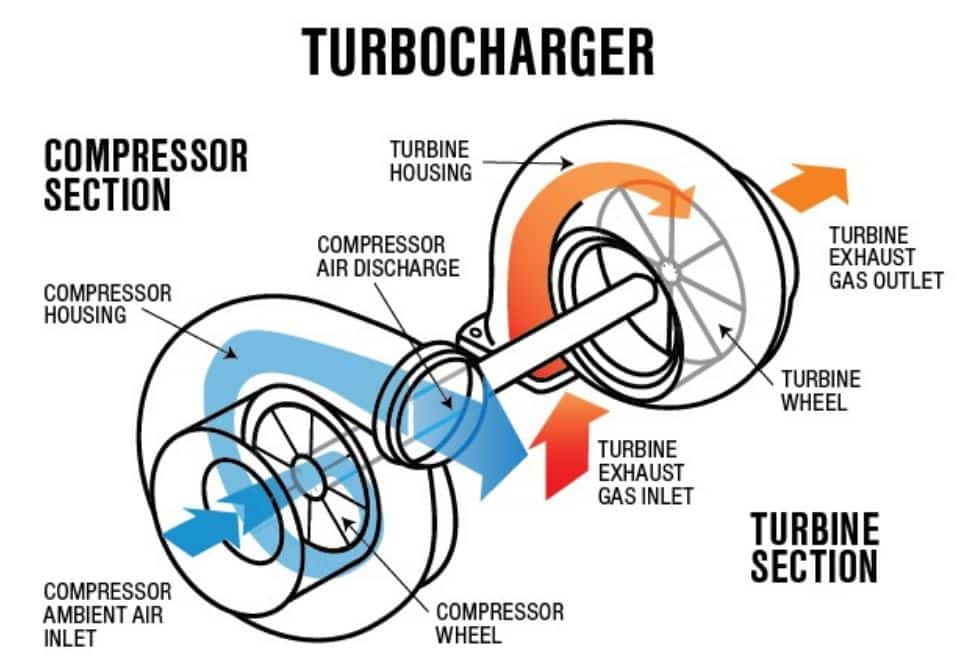
The turbine housing is meant to guide the exhaust gas into the turbine wheel. The energy released from the exhaust gas causes the turbine wheel to spin, so the gas leaves the turbine housing through an exhaust outlet area.
Now, the compressor section also includes the compressor wheel to convert some of the energy and the compressor housing for protection. The mode of action of the compressor is opposite to that of the turbine.
A compressor wheel is connected to the turbine by a forged steel shaft, and as the turbine turns the compressor wheel, the high-velocity spinning draws the air and compresses it.
Then, the compressor housing turns the high-velocity, low-pressure air stream into a high-pressure, low-velocity air stream by a process termed diffusion. And finally, compressed air is pushed into the engine, causing the engine to burn more fuel to produce more energy.
Read Also: What is Manual Transmission? And How It Works?
Types of Turbochargers
Following are the types of turbochargers used in automobiles:
- Single-Turbo
- Twin-Turbo
- Twin-Scroll Turbo
- Variable Geometry Turbo
- Variable Twin Scroll Turbo
- Electric Turbo
#1 Single-Turbo
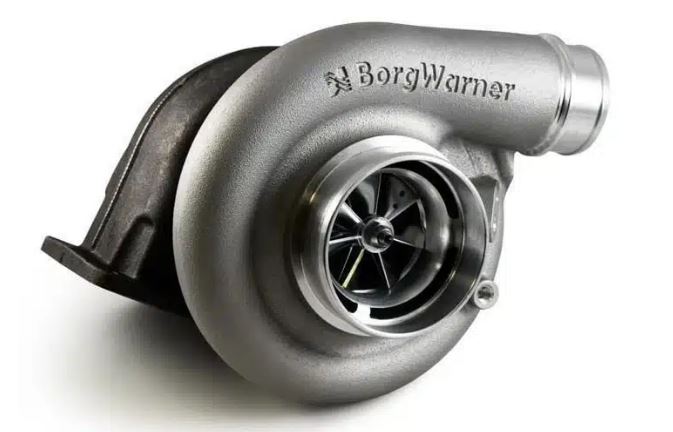
The most common type of turbocharger is a single turbocharger. Different torque characteristics can be obtained by varying the size of the components within the turbo. The larger turbos give higher levels of top-level power, while tinier turbos can spool quicker and produce better low-end power.
They are costly to increase engine power and efficiency, and as they have become more popular, they allow small engines to increase efficiency by naturally producing the same power as larger engines, but with less weight.
However, they work best in a narrow RPM range, and drivers will usually feel “turbo-lag” till the turbo starts operating within its peak rev band.
| Advantages of Single-Turbo | Disadvantages of Single-Turbo |
|---|---|
| It is cost-effective for increasing the power and efficiency of the engine. | The response of a single turbo maybe not be as fast as the other types of turbos. |
| It is the simplest type of turbocharger and is usually easy to install. | The response of a single turbo maybe not fast as the other types of turbos. |
| Single-turbos are used for smaller engines to produce the same power as larger engines. So, they can often reduce weight. |
#2 Twin-Turbo
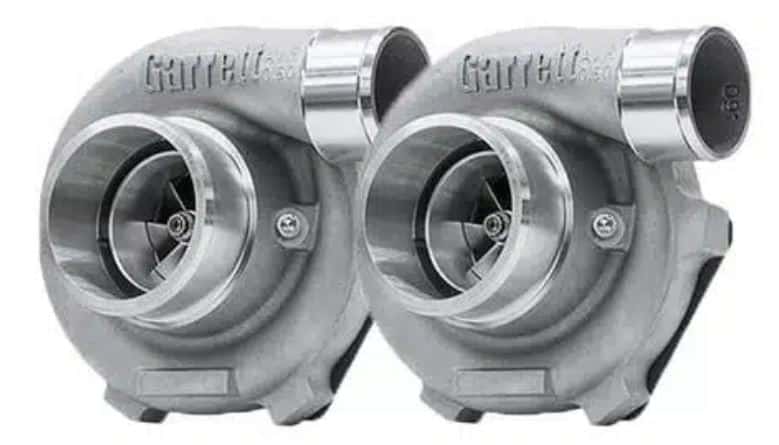
In a twin-turbo turbocharger, there is a second turbocharger in the engine. A V6 or V8 engine, this can be done by allowing a single turbo to work with each cylinder bank. Alternatively, a smaller turbo can be applied at lower RPMs, with a larger turbo for higher RPMs.
The second configuration allows for a wider operating RPM range and gives better torque at lower revs (reducing turbo lag), but also power at higher RPM. It is known as twin sequential turbocharging. Unexpectedly, having two turbos greatly increases complexity and costs.
| Advantages of Twin-Turbo | Disadvantages of Twi-turbo |
|---|---|
| The benefits and drawbacks are similar to the single turbo setup for a parallel twin-turbo on a ‘V-shaped engine. | It requires higher cost and is somewhat complex because of the usage of doubled components. |
| Concern a sequential turbo or using a turbo at low and high rpm allow for a much wider and flatter torque curve. Better low-end torque, but it won’t lose power at high RPM like a smaller single turbo. | There are lighter and more efficient for achieving similar results. |
#3 Twin-Scroll Turbo
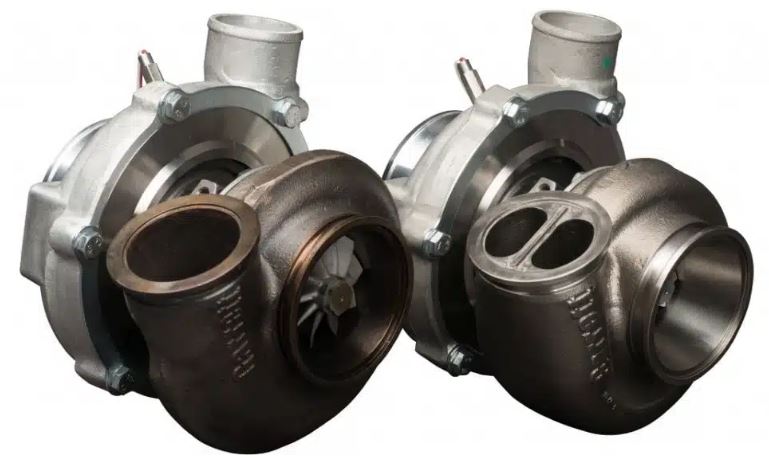
These types of turbochargers need a split inlet turbine casing and exhaust manifold that individually joins the correct engine cylinder with each scroll.
For example, in a four-cylinder engine (with firing order 1-3-4-2), cylinders 1 and 4 can support one turbo scroll, while cylinders 2 and 3 feed a different scroll. This layout gives the turbo an efficient distribution of gas exhaust energy and helps provide condensed, pure air in each cylinder.
The more energy is sent to the exhaust turbine, which means more power. Repeat, there is a major cost for approaching the complexity of a system that requires complex turbine housing, exhaust manifolds, and turbos.
| Advantages of Twin-scroll Turbo | Disadvantages of Twin-scroll Turbo |
|---|---|
| Since more energy is sent to the exhaust turbine, you can generate more power. | It needs a specific engine layout and exhaust design. |
| A wide RPM range of effective boosts can be possible based on various scroll designs. | These are costly and complex compared to conventional single turbos. |
| You can get more tuning flexibility because more valve overlap is possible without interrupting the exhaust scavenging. |
Read Also: Understand The Part and Function of Ignition Distributor
#4 Variable Geometry Turbo
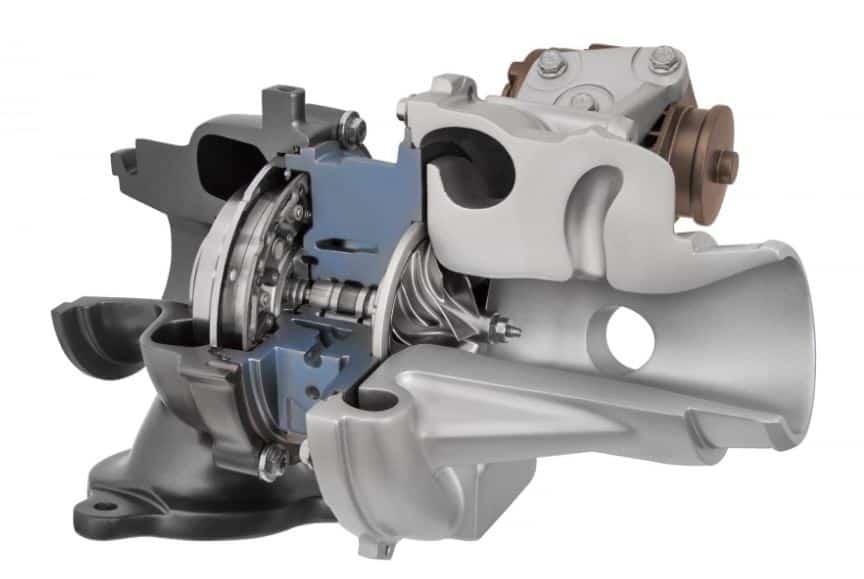
These types of turbochargers are also known as variable nozzle turbines. It is commonly used in diesel engines because the exhaust gases in diesel engines are low, the heat will not harm the vanes.
Variable geometry turbo consists of a ring of vanes of aerodynamic shape in the turbine housing at the turbine inlet. It is complex in design and requires a higher cost than other types. Now VGTs are limited due to their cost in petrol engine applications.
Because of their ability to change the area-to-radius ratio, these types of turbochargers result in a wider boost range and shorter lag times so that it matches the engine RPMs. This design allows the aspect ratio of the turbocharger to change when the position is changed.
| Advantages of Variable Geometry Turbo | Disadvantages of Variable Geometry Turbo |
|---|---|
| They provide a wide and flat torque curve and provide effective turbocharging over a wide RPM range. | These are commonly used in diesel applications, where exhaust gases are low, so heat does not damage the vane. |
| Only one turbo is needed to simplify the sequential turbo setup. | This requires a higher cost because foreign metals have to be used to maintain reliability for gasoline application. |
5. Variable Twin Scroll Turbo
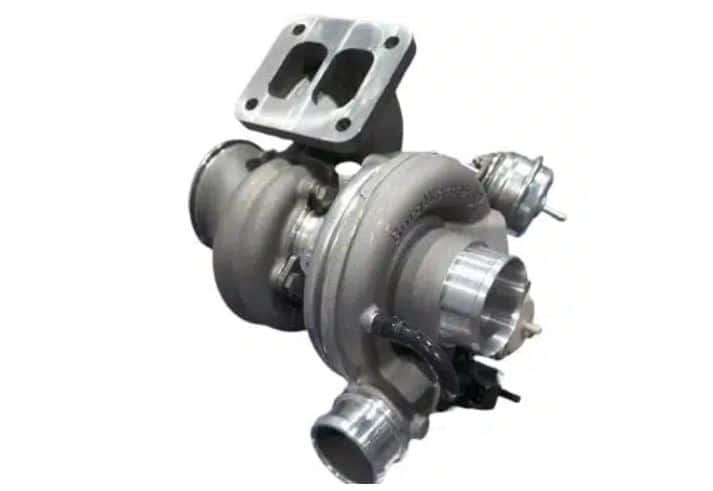
The variable twin-scroll turbo combines twin-scroll turbo and variable geometry turbo. This turbo allows good high-end performance in any vehicle. This design provides exhaust airflow to be directed into only a single scroll.
In addition, it also provides the amount of the valve to open to allow gases to split in both scrolls if needed. The VTS turbocharger design gives a cheaper and more robust option to the VGT turbo, which is a good option for petrol engine applications.
| Advantages of Variable Twin Scroll Turbo | Disadvantages of Variable Twin Scroll Turbo |
|---|---|
| These are cheaper than variable geometry turbo, so it allows gasoline turbocharging. | It requires a higher cost and is complex compared to a single turbo or common twin-scroll turbo. |
| They also provide a wide and flat torque curve. | This technique has been worked with before but is not sustainable in production. |
| They are more robust in design than variable geometry turbo based on material selection. |
#6 Electric Turbo
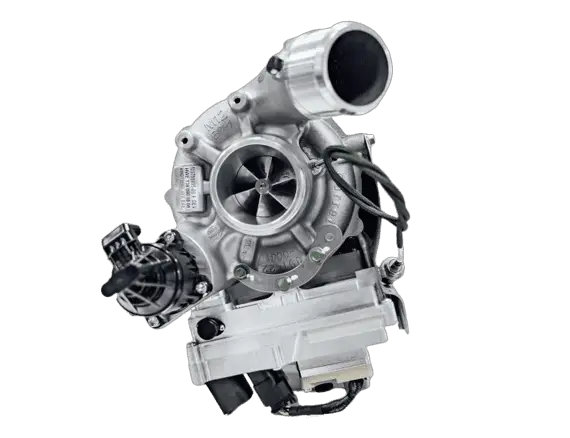
Electric turbos are the latest and recently added to the turbocharger industry. It is completely different from the other types of turbochargers. They reduce the turbo lag and assist a normal turbocharger at low engine speeds.
This is done by attaching an electric motor that rotates the compressor from the start and through the lower revs until the power from the exhaust volume is sufficient to make the turbocharger work.
These types of turbochargers have one drawback that it is quite expensive and complex. This turbocharger choice also allows for the consumed energy to be recovered and used to generate power.
| Advantages of Electric Turbo | Disadvantages of Electric Turbo |
|---|---|
| Turbo lag and exhaust gases are easily eliminated by connecting an electric motor directly to the compressor wheel. | Higher costs are required and are complicated, as you must now consider the electric motor and ensure that it remains cool to prevent safety issues. |
| The wasted energy is recovered by connecting an electric motor to an exhaust turbine. | VGTs or twin scrolls can provide similar benefits at a significantly lower cost. |
| It provides a wide effective RPM range with full torque. |
Read Also: What is Wankel Rotary Engine? And How It Works?
Why Turbocharger is Needed?
In general, engines suck air directly from the atmosphere. So, they do not suck enough air out of the atmosphere for combustion. This may be due to the high speed or the engine’s design.
In that case, you need to use an external device to provide air to the engine for the entire combustion, and this device is known as a turbocharger. A turbocharger obtains energy from exhaust gases to do its work.
Applications of Turbocharger
Turbochargers were mainly employed to increase the air going into the engine. And also increases the amount of fuel that can be combusted efficiently, increasing power.
Power is also improved by increasing the size of the engine, but this will increase the weight and internal friction, increasing fuel consumption.
The turbocharger performs an important role in the IC engine. This increases the volumetric efficiency of the IC engine cylinder by giving it compressed air. Therefore it benefits radiation control. So it is used in aerospace, automotive, marine, and energy sector applications.
Read Also: What is the Purpose of a Cylinder Head in Engine?
Advantages of Turbocharger
It is crucial to be aware of the numerous benefits of turbocharger. Let’s explore further to learn more:
- When compared to naturally aspirated engines, turbochargers are more powerful.
- Thermal efficiency is higher than naturally aspirated and supercharged engines since the exhaust is used for valuable work instead of waste.
Disadvantages of Turbocharger
Knowing only the benefits is insufficient, so let’s explore the potential drawbacks of a turbocharger:
- If the turbo is large, the boost is gradually increased with more exhaust pressure to overcome the rotational inertia of the large turbine and reduce the throttle response.
- If the turbo is too small, the turbo lag is reduced. Also, the peak power is reduced.
- Because complex turbochargers often spin at higher revolutions, proper cooling, and lubrication are essential.
FAQ
A turbocharger is a part of turbine-powered forced induction, which develops an engine’s efficiency and power output by forcing more air into the combustion chamber.
By using a turbocharger in your car, the engine can provide greater power density and increased fuel efficiency to your car. Since a turbocharger allows smaller engines to give more power, manufacturers can reduce their engine displacement.
Wrapping it up
A turbocharger is attached to an engine to deliver more power. This enables smaller engines to produce more horsepower and torque than normal. It uses the heated and expelled air from the engine to rotate the compressor wheel and take the outside air.
So for now, I hope that you have learned about the different types of turbochargers. If you have any questions or doubts about this article you can ask in the comments.
If you liked this article, please share it with your friends. Subscribe to our newsletter to be notified when we upload new posts. It’s free.
Download The PDF file of this article
Read more in our blog:
- What is Supercharger? And Types, Working, Advantages, and More (PDF)
- What is Torque Converter as a Fluid Coupling? Its Construction and Parts
- Types of Gearbox: Parts, Working with Diagram [PDF]
- Understand The Working of the Propeller Shaft
- Everything You Should Know About The Engine Flywheel
- What is a function of a crankshaft? And why is it important?
- What is the difference between a disc brake and a drum brake?
- Types of Chassis & Frame [Comprehensive Guide]
- Different Types of Tires for Cars [Benefits & Drawbacks]
- 6 Different Types of Lubrication System in Automobile